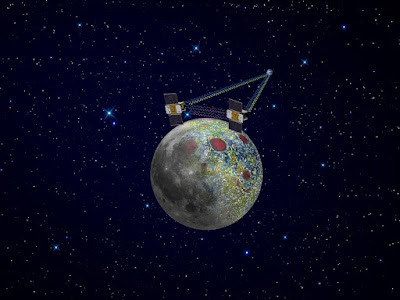Far side of the Moon - Wikipedia, the free encyclopedia
Far side of the Moon, photographed by Apollo 16
The far side of the Moon, also called the dark side of the Moon, is the lunar hemisphere that is permanently turned away, and not visible from the surface of the Earth.[...]
Tidal forces from Earth have slowed down the moon's rotation so that the same side is always facing the Earth, a phenomenon called tidal locking. The other face, most of which is never visible from the Earth (18% of it can be observed over time due to libration), is therefore called the "far side of the Moon". The far side should not be confused with the "dark side" (the hemisphere that is not illuminated by the Sun at a given point in time), as the two are the same only during a full moon and, during a new moon, the near side is the dark side. Both the near and far sides receive (on average) almost equal amounts of light from the Sun. However, the term "dark side of the moon" is commonly used poetically to refer to the far side.[1]
NASA orbiter gives glimpse of moon's far side - CNN.com
The GRAIL mission's Ebb spacecraft took this picture of the south pole of the far side of the moon.
STORY HIGHLIGHTS
- A 30-second NASA video scans the far side of the moon
- It came from one of two probes that entered lunar orbit around New Year's
- Ebb and Flow are to chart lunar gravitational field for 82 days
GRAIL consists of two identical spacecraft, recently named Ebb and Flow, each of which is equipped with a MoonKAM. The images were taken as part of a test of Ebb's MoonKAM on Jan. 19. The GRAIL project plans to test the MoonKAM aboard Flow at a later date.
[...]
Launched in September 2011, Ebb and Flow periodically perform trajectory correction maneuvers that, over time, will lower their orbits to near-circular ones with an altitude of about 34 miles (55 kilometers). During their science mission, the duo will answer longstanding questions about the moon and give scientists a better understanding of how Earth and other rocky planets in the solar system formed.
Source: First Video From Moon's Far Side
NASA - GRAIL Artist's Rendition
Using a precision formation-flying technique, the twin GRAIL spacecraft will map the moon's gravity field, as depicted in this artist's rendering. Radio signals traveling between the two spacecraft provide scientists the exact measurements required as well as flow of information not interrupted when the spacecraft are at the lunar farside, not seen from Earth. The result should be the most accurate gravity map of the moon ever made.
Source: NASA - GRAIL Artist's Rendition
Related
- Moon's Far Side Video, Taken By NASA's GRAIL Probe, Is First Ever (VIDEO)
- Probe takes first video of moon's far side - Technology & science - Space - Space.com - msnbc.com
- Dark side of the moon: NASA releases first ever glimpse of the side we never see | Space, Military and Medicine | News.com.au
- NASA probe captures 1st video of moon’s far side | KurzweilAI
- NASA - NASA Mission Returns First Video From Moon's Far Side
- NASA - The Far Side of the Moon -- And All the Way Around



